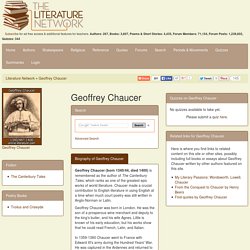

Archbishop of Canterbury. Alternative titles: Thomas à Becket; Thomas of London Becket, Saint Thomas: Murder of Thomas BecketBy permission of the British Library Saint Thomas Becket, also called Thomas À Becket, or Thomas Of London (born c. 1118, Cheapside, London—died December 29, 1170, Canterbury, Kent, England; canonized 1173; feast day December 29), chancellor of England (1155–62) and archbishop of Canterbury (1162–70) during the reign of King Henry II.

His career was marked by a long quarrel with Henry that ended with Becket’s murder in Canterbury cathedral. Thomas was born to Norman parents of the merchant class. History - Thomas Becket. Geoffrey Chaucer. Geoffrey Chaucer (born 1340/44, died 1400) is remembered as the author of The Canterbury Tales, which ranks as one of the greatest epic works of world literature.

Chaucer made a crucial contribution to English literature in using English at a time when much court poetry was still written in Anglo-Norman or Latin. Geoffrey Chaucer was born in London. He was the son of a prosperous wine merchant and deputy to the king's butler, and his wife Agnes. Little is known of his early education, but his works show that he could read French, Latin, and Italian. In 1359-1360 Chaucer went to France with Edward III's army during the Hundred Years' War. Between 1367 and 1378 Chaucer made several journeys abroad on diplomatic and commercial missions.
Chaucer took his narrative inspiration for his works from several sources but still remained an entirely individual poet, gradually developing his personal style and techniques. History - Geoffrey Chaucer. Geoffrey Chaucer (c.1343-1400) Welcome to the Luminarium Chaucer page.

Here you will find a Chaucer Biography, Chaucer's Works, Quotes, Essays and Articles, as well as links to study resources and a list of books helpful for further study. All of these can be accessed from the red navigation bar at the top. The sidebar on the right has links to Medieval writers and works, historical persons and events, and concepts relevant to the study of Chaucer. Many of these links lead to the Luminarium Encyclopedia. And don't forget to visit the Chaucer Discussion Board to chat and ask any questions that may crop up. Geoffrey Chaucer - Author, Poet. English poet Geoffrey Chaucer wrote the unfinished work, The Canterbury Tales.

It is considered one of the greatest poetic works in English. Synopsis Poet Geoffrey Chaucer was born circa 1340 in London, England. In 1357 he became a public servant to Countess Elizabeth of Ulster and continued in that capacity with the British court throughout his lifetime. The Canterbury Tales became his best known and most acclaimed work. Early Life Poet Geoffrey Chaucer was born circa 1340, most likely at his parents’ house on Thames Street in London, England. Geoffrey Chaucer is believed to have attended the St. In 1357, Chaucer became a public servant to Countess Elizabeth of Ulster, the Duke of Clarence’s wife, for which he was paid a small stipend—enough to pay for his food and clothing.
In 1366, Chaucer married Philippa Roet, the daughter of Sir Payne Roet, and the marriage conveniently helped further Chaucer’s career in the English court. Public Service Major Works Later Life Death. Geoffrey Chaucer. Geoffrey Chaucer was born in London sometime between 1340 and 1344 to John Chaucer and Agnes Copton.

John Chaucer was an affluent wine merchant and deputy to the king’s butler. Through his father’s connections, Geoffrey held several positions early in his life, serving as a noblewoman’s page, a courtier, a diplomat, a civil servant, and a collector of scrap metal. His early life and education were not strictly documented although it can be surmised from his works that he could read French, Latin, and Italian. In 1359, Chaucer joined the English army’s invasion of France during the Hundred Years’ War and was taken prisoner; King Edward III of England paid his ransom in 1360. In 1366, Chaucer married Philipa de Roet, who was a lady-in-waiting to Edward III’s wife. Chaucer’s early work is heavily influenced by love poetry of the French tradition, including the Romaunt of the Rose (c. 1370) and Saint Cecilia (c. 1373), later used as the “Second Nun’s Tale” in the Canterbury Tales.